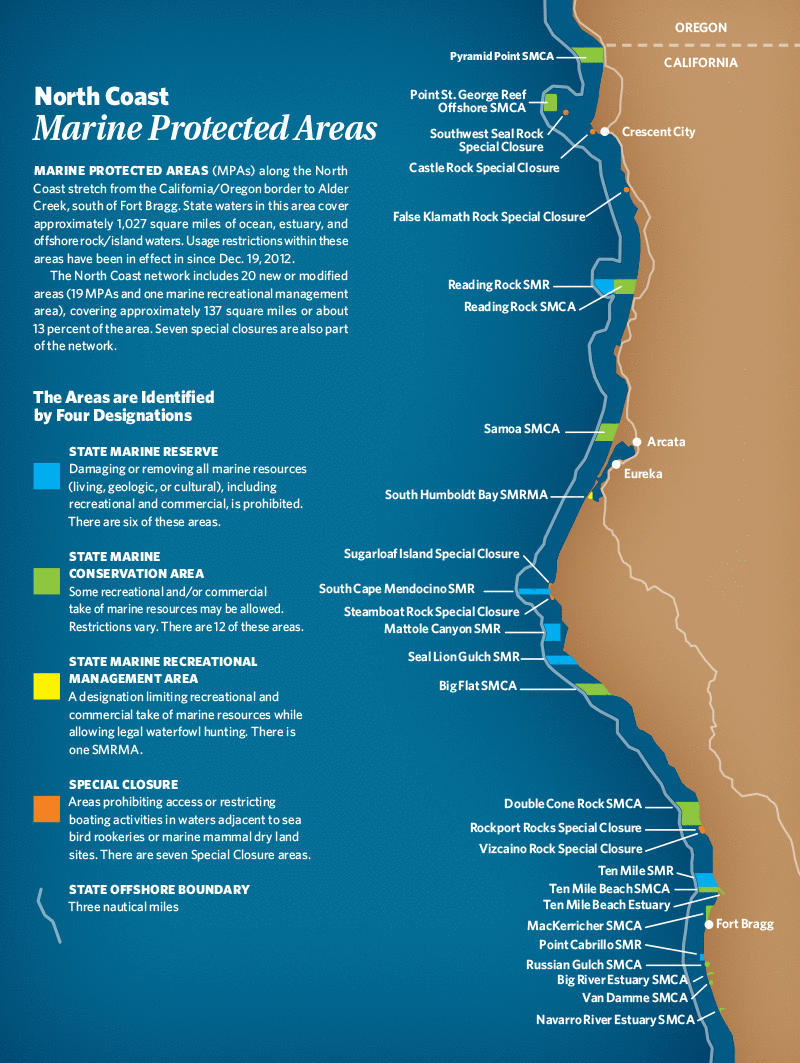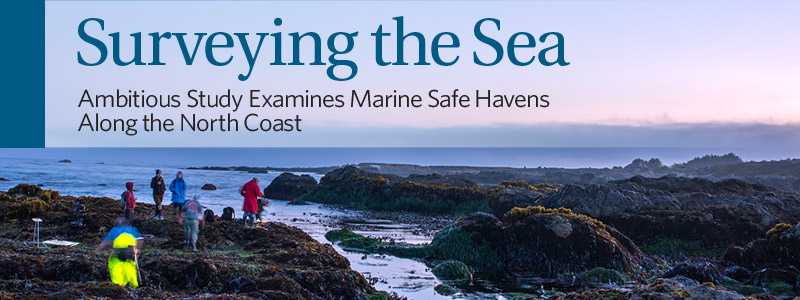
HSU researchers and volunteers search for sea life in the predawn light as part of their research on the rocky intertidal ecosystem off the North Coast. The group’s findings, along with those compiled by other researchers, will help establish a baseline for future studies measuring the effectiveness of California’s Marine Protected Areas.
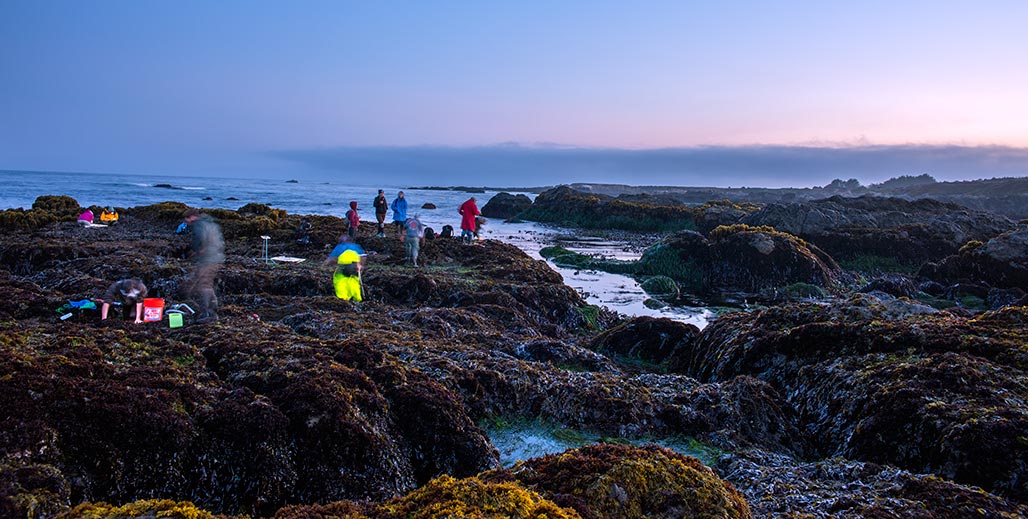
In California and around the world, networks of marine protected areas (MPAs) have been established to promote recovery from pollution, climate change, and over-exploitation of ocean resources. On the North Coast, Humboldt State faculty and student researchers are working to establish a benchmark that will help determine whether the MPA program can safeguard the ocean’s bounty for the economic and recreational benefit of future generations.
IT WAS 5 O’CLOCK, and the sun had yet to creep above the horizon on a North Coast summer morning, when Sean Craig and his team discovered hidden treasure.
“My crew and I got there, and we were stumbling across rocks in the dark, and somebody said, ‘Hey, I see an abalone,’” says Craig, professor of Biological Sciences.
“Somebody else said, ‘Hey, I see two.’ Pretty soon, I’m looking around, and I see two, three, a dozen abalone within reach just below the water line. That was the first time I’d ever seen anything like that in the intertidal zone. It’s how one could imagine Northern California’s entire coastline could have looked in the past.”
Craig is one of 13 HSU faculty members examining the northernmost region of California’s Marine Protected Areas (MPAs), zones designated by the state as reserves where commercial and recreational activity is limited. To Craig, the startling discovery of plentiful mollusks in an unprotected area was an increasingly rare find.
Unprotected zones like this, which usually show the results of overuse, including a decline in habitat and sealife, are important to the team’s research. They offer a comparison to the protected areas, which will help scientists determine the effectiveness of MPAs.
Like the redwood forest that lies a short distance inland from its shores, the Pacific coastline of Northern California is a natural wonder. It attracts tourists and other recreational users, from surfers to waterfowl watchers. In years past, it was a highly-productive commercial and sport fishery, and among the key drivers of the local economy.
For decades, these coastal waters have also served as a laboratory for Humboldt State students. Countless research projects and theses have been generated. With a long-standing reputation for excellence, the marine sciences at HSU show no signs of stagnation, and may in fact be experiencing a golden age, thanks to a mix of veteran and new faculty, state-of-the-art equipment and facilities, and new projects.
“Getting out there, getting dirty, and taking part in field research like this is such a wonderful opportunity that can teach you so much and be, in some ways, essential to shaping your goals, interests, and aspirations within your field,” says senior Marine Biology major Johnny Roche. “That kind of exposure is unlike any other, it’s the real deal.”
Roche is one of approximately 40 graduate and undergraduate students working on the MPA baseline project. An expansive and potentially impactful study, the effort represents one of the biggest conservation projects of its kind in the world, according to researchers.
Conserving California’s Coastline
AN INITIATIVE aimed at sustaining coastal resources, the establishment of California’s Marine Protected Areas began in 2007, and has been gradually implemented along California’s coastline. The North Coast, which stretches from Alder Creek, near Fort Bragg, to the Oregon border, is the final region being studied as part of the program, and like the others, will establish a baseline for future studies of MPAs that will measure their effectiveness. Enter the HSU scientists and students.
The three-year assessment is funded by $4 million awarded through 10 grants from the California Ocean Science Trust. Humboldt State’s researchers received $2.2 million of that total, and serve as lead investigators on seven of the 11 studies.
HSU’s field research, which began in 2014, will continue into the summer of 2015. The final year of the project will focus on data processing and analysis.
Most of the studies include population censuses of marine life in various ecosystems, including estuarine, near-shore rocky reef and kelp forests, mid-depth and deep-water habitats, near-shore fish communities, and sandy beach and surf zones. There are also components that examine seabirds as indicators of oceanographic conditions.
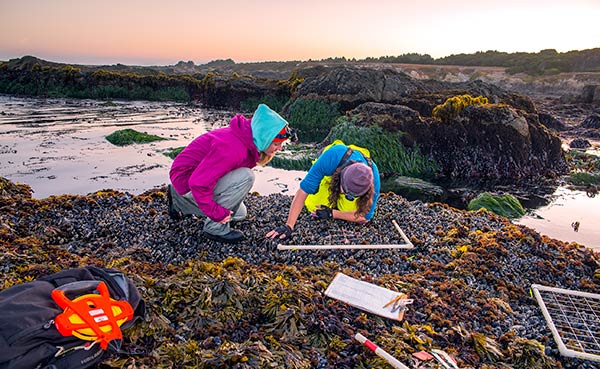
Graduate student Jason Lopiccolo (on hands and knees) and undergraduate Leslie Booher take sub-samples of a quadrant within an intertidal mussel bed.
“The baseline projects take a look at the abundance and diversity of marine plants and animals in several ecosystems,” says Tim Mulligan, professor of Biological Sciences and lead researcher on two of the studies. “The greatest value is getting the snapshot of what’s there now. There are places like Pyramid Point, Sea Lion Gulch, and South Cape Mendocino, that haven’t been well studied before.”
Whether the MPA program achieves one of its goals—an increase in healthy sea life that will populate other areas—is a long way from being determined. And the process itself can be somewhat contentious.
“The state’s rolling out of protected areas has involved multiple meetings with tribes and other people, and to make a long story short, not everyone’s so keen on it,” says Craig. “They’ve observed the establishment of MPAs, and say, ‘you want another area?’”
Addressing that resistance, Humboldt State professors and other researchers worked to form collaborative partnerships. Some hesitance is appropriate, they say, and the reasons behind it need to be respected.
“MPAs are a conservation tool that has been shown globally to be very important, but there’s a need to consider every case on its own,” says Brian Tissot, director of HSU’s Marine Lab and the newly-established Humboldt Marine & Coastal Science Institute. “How it affects the people, locally, is equally important. Ideally, there would be a balance that conserves nature without displacing or disrupting the lives of the people that rely on it.”
Of the 1,027 square miles of ocean, estuary, and offshore rocky coastline off the North Coast, MPAs are limited to 137 square miles, or 13.3 percent. Still, the opinion of many scientists is that the protected areas’ effectiveness is unproven.
“A lot of people feel the MPA program is a panacea. I see it as one possible tool that might work under the right circumstances,” Tissot says. “What’s important is how the processes are established. If it isn’t done right, it could damage potential conservation efforts in the future.”
Human Dimension
LIKE THE OCEAN FLORA and fauna being studied, the human dimension of the state’s MPA effort is diverse. Commercial fisherman, recreational users, and Native American tribes are all impacted by conservation efforts. The latter group’s interest is rooted in culturally significant traditions.
Since long before white settlement, the natural resources of the North Coast have been a critical source of sustenance and cultural significance to Indian tribes. In the mid-1800s, a large influx of settlers came to the North Coast, and when the gold rush that lured them slowed in the late 1800s, they turned to other natural resources in the area—massive redwood forests and abundant fishery resources such as salmon, groundfish and crab.
Offering a unique perspective, tribal representatives have been heavily involved in the study. Observation and information, passed along over several generations of indigenous people, help establish a historical view for the MPA research—a baseline for the baseline.
HSU alumna Megan Rocha (’00, Social Science) represents the Smith River Rancheria and a more expansive coalition of tribes as principal investigator on one of the projects. Having grown up in southern Humboldt County, Rocha has a solid grasp of the local community’s history. Representing the Yurok tribe, she was involved early on in California’s MPA implementation, and observed what worked and what didn’t in other regions. Midway through the North Coast part of the study, she’s also observed a difference.
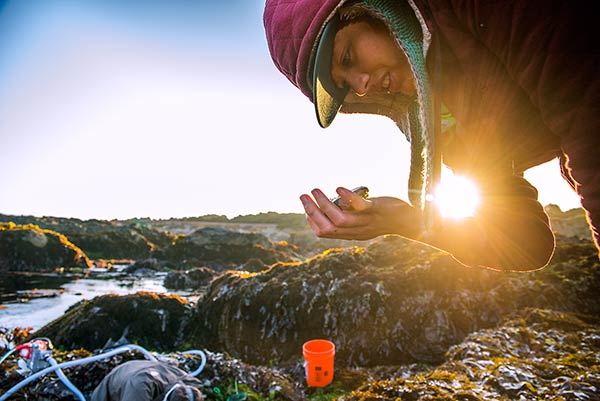
A student involved in the MPA baseline study examines a chiton, an animal that grazes on algae found on rock surfaces in the intertidal zone.
“For a couple of years, when the state first established the MPAs, there was this initial questioning about how the tribes would be involved,” Rocha says. “We needed answers about what this means for traditional fishing and gathering rights.
“Before the MPA folks even arrived on the North Coast, there had already been a lot of relationship building. At the end of the day we had fishermen, environmental groups, government officials, and researchers really supporting the tribes. It was pretty amazing. It was a moment when I felt very proud to be a part of this community.”
HSU scientists share that feeling, and the benefit of the collaboration will extend beyond this particular study, says Mulligan.
“We’re engaged with a group that has just been wonderful to work with,” Mulligan says. “They’ve been generous with their time and resources. Just getting to know the tribal members and how they work and fit into the natural resources picture on the North Coast has been an eye-opener for me. And it’s been a lot of fun.”
Also impacted by declining ecosystems are commercial and recreational fishermen, many of whom view MPAs as further limiting their already-declining resources.
According to a California State Coastal Conservancy study, the amount of ocean sealife harvest on the North Coast has sat below 45 million pounds per year since 1998, and the value of the catch has dropped to $50 million, compared to a peak in 1988 of 103.7 million pounds of harvest and a catch value of $80.4 million. The number of boats also declined precipitously from a peak of 2,550 in 1981 to 500 or fewer boats since 2005. Why and how that is happening are viable questions, and getting to the heart of them is another question researchers are examining.
“Building trust so that people are comfortable sharing information with us is extremely important,” says Steve Hackett, chair and professor in HSU’s Department of Economics. “That’s something we work really hard at—being clear and transparent about our purpose and what we’re doing.”
“We” includes Hackett, who is taking the lead on the socioeconomic segment of the study, Laurie Richmond, in her third year as a professor of Environmental Science and Management at HSU, and a team of students and volunteers. Richmond’s past research and interaction with fishing communities has played an important role in understanding the effects of MPAs.
Richmond’s staff conducted interviews of more than 150 individuals, from the Oregon border to Albion, a Mendocino County town nearly 160 miles south of Arcata. They found some reluctance to accept conservation efforts, but key to building a bridge between the constituencies was establishing an advisory panel of commercial and charter boat operators representing the primary ports and fisheries along the North Coast.
“A lot of fishermen are feeling like all these regulatory decisions are happening and they don’t have any control,” says Richmond. “The challenge for fishermen is that they’re already regulated, and MPAs feels like a new layer. They question how much conversation, how much economic benefit there will be. It’s important that they have a voice.”
Finding Funding
ROCHA IS ALSO A PART of Tissot’s Marine & Coastal Science Institute executive committee, a group of individuals representing a variety of industries, along with tribal representatives, nonprofit groups, environmental groups, and the government. Input from board members, as gleaned from their constituencies, will help shape future endeavors.
“We’ve really asked the community, in a broad sense, what issues are they facing, and how Humboldt State can work with them to help solve some of those problems,” Tissot says. “What studies do they need, what research do they need, and then collectively, where can we find funding for this.”
Part of Tissot’s role, with the help of the board and other researchers, is to secure that kind of funding. Most recently, he and HSU faculty members Eric Bjorkstedt and Jeffrey Abell acquired a $272,000 grant from the National Science Foundation to study the effects of low pH and low dissolved oxygen on juvenile rockfish along the North Coast.
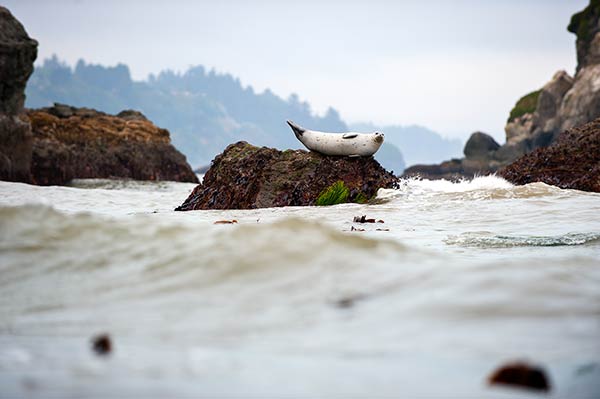
One of the goals of the MPA research is to preserve ecosystems that support wildlife, like this harbor seal in Trinidad.
“Most of our faculty teach many classes, which limits their time to do research,” Tissot says. “If somebody can facilitate the funding efforts, it makes it easier for everybody. The time that they do have is then spent doing the research and working with students, which is what you want them to do.”
Mulligan, the Biological Sciences professor, is semi-retired from teaching and has increased his focus on research. An HSU faculty member since 1987, he is now channeling his energy into a variety of projects.
On a visit to the HSU Marine Lab in Trinidad, Mulligan’s enthusiasm is obvious as he shows off the renovated facility. Upgraded plumbing and electrical infrastructure, controlled researched facilities, and attractive displays are all parts of Mulligan’s tour, a room-to-room scurry that allows him to keep his busy schedule on track.
“It’s been a great undertaking. It’s really been brought up to standards,” says Mulligan, during a stop in a room filled with microalgae culture experiments. “The students appreciate it. They notice the difference.”
External sources—the National Science Foundation, United Plankton Foundation, and Desert Community Foundation—stepped in to fund the upgrades with a total of $310,000. Individual donors have also provided key sources for development, sometimes through unusual channels.
An example came last spring when, via an alumnus connection, a remotely operated vehicle was gifted to HSU’s California Cooperative Fish and Wildlife Research Unit by the U.S. Naval Facilities Engineering and Expeditionary Warfare Center at Port Hueneme, Calif., for use by faculty and students.
Student Involvement
Another tradition established in the marine sciences and other Humboldt State programs is hands-on learning. The MPA studies exemplify that approach, with roughly 40 graduate and undergraduate students involved in both fieldwork and data processing.
Katherine Osborn, a graduate student in Fisheries Science who’s worked for three seasons with the California Department of Fish and Wildlife, also recognizes the value of student research. Some experiences working on the MPA’s estuary baseline study have proven more than routine.
“My favorite moment is still when a male bay pipefish started giving birth on the measuring board,” says Osborn. “Yes, we released the babies and the proud papa alive.”
A goal of the researchers is to extend the learning opportunity to other campus departments. Richmond and Hackett have seen the benefits, and would like the strategy to spread.
“There’s a genuine desire among departments to be interdisciplinary,” Richmond says. “I’m on incredible theses committees of students who are bridging fields, doing environmental research and looking at policy at the same time.”
Hackett has been a proponent of the interdisciplinary approach for decades, both during his time at Humboldt State and previously at Indiana University. He, too, appreciates the cooperation.
“Here at Humboldt, the hard scientists understand the significant role of social science components,” Hackett says. “People want to be collaborative and work together.”
Will it Work?
Students like Osborn and Roche say they appreciate what the North Coast environment offers, and the opportunities Humboldt State’s marine science programs incorporate into the student experience. Initiatives like the MPA baseline study offer a glimpse of the present marine climate that drew them here to pursue their education, but follow-up and funding are keys to the future.
“To evaluate the effectiveness of the MPAs, these studies have to be followed up,” Mulligan says. “Whether that money becomes available or not remains to be seen, but I think we can make a strong argument that we’ve got to do follow-up research. We’re hopeful that in five years funding will come from somewhere, whether it’s state, federal, or private.”
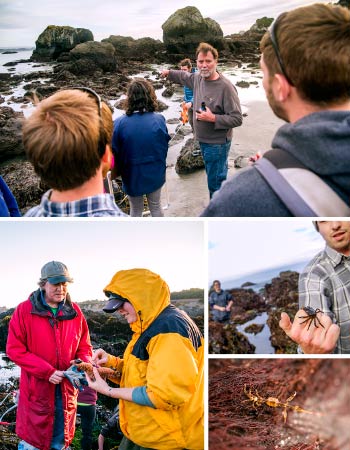
CLOCKWISE FROM TOP: Brian Tissot, director of HSU’s Marine & Coastal Science Institute, describes the marine life census process to students during a fieldtrip to Old Home Beach in Trinidad. • A juvenile kelp crab clings to an undergraduate researcher's hand. • Small skeleton shrimp are abundant within clumps of red algae in the intertidal zone. • Professor Sean Craig (left) and graduate student Jana Henessy examine the condition of an Ochre sea star for presence of sea star wasting disease.
“Getting out there, getting dirty, and taking part in field research like this is such a wonderful opportunity that can teach you so much. That kind of exposure is unlike any other; it’s the real deal.”
Marine Biology major, Johnny Roche
North Coast Marine Protected Areas
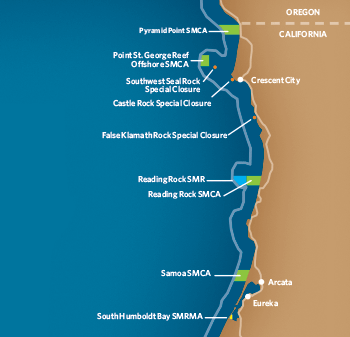
North Coast Marine Protected Area Baseline Study
HSU researchers are examining the current state of marine life in protected and unprotected areas to provide baseline information for future research. Here’s a look at what they’re studying to create that reference point.
Estuarine Ecosystems
Frank Shaughnessy, Lead Researcher, Botany
Timothy Mulligan, Fisheries Biology
Plants, invertebrates, and fishes in tidal mudflats and eelgrass beds in four of the previously
less-studied 16 major North Coast estuaries.
Sandy Beach and Surf-zone Ecosystems
Sean Craig, Lead Researcher, Marine Ecology
Timothy Mulligan, Fisheries Biology
Shorebirds and the habitat of invertebrates they feed upon.
Rocky Intertidal Ecosystems
Sean Craig, Lead Researcher, Marine Ecology
Andrew Kinziger, Fisheries Biology
Biodiversity of approximately 25-30 fish species that inhabit North Coast tide pools.
Rocky Reefs and Kelp Forests
Sean Craig, Lead Researcher, Marine Ecology
Ryan Jenkinson, Biological Sciences
Density of macroinvertebrates, macroalgae, and benthic fishes, and populations of red sea urchin and red abalone.
Fish Communities Associated with Rocky Reef Habitats
Timothy Mulligan, Lead Researcher, Fisheries Biology
Dave Hankin, Fisheries Biology
Drew Barrett, Fisheries Biology
Status of nearshore rocky reef fish in four of the region’s MPAs.
Seabirds
Richard Golightly, Lead Researcher, Wildlife
Daniel Barton, Wildlife
Reproductive rates, diet, and related interannual variance at select colonies to identify how the marine predators are being affected by the MPAs.
Human Uses and the Socioeconomic Dimensions of MPAs
Steven Hackett, Lead Researcher, Economics
Laurie Richmond, Environmental Science and Management
Status of the region’s fishing communities.
Oceanographic Conditions
Eric Bjorkstedt, Lead Researcher, Fisheries Biology
Brian Tissot, Humboldt Marine & Coastal Science Institute
Processes that drive the region’s biological variability.
Note: Representatives from UC Santa Cruz, Sonoma State, UC San Diego, UC Davis, and San Jose State are also involved on a number of the listed projects, and four other initiatives. Also involved in the MPA study are representatives from the Bodega Marine Laboratory, H.T. Harvey & Associates, the Wiyot Tribe, Smith River Rancheria, Reef Check California, Crescent Coastal Research, Point Blue Conservation Science, InterTribal Sinkyone Wilderness Council, Cher-Ae Heights Indian Community of the Trinidad Rancheria, Point 97, Farallon Institute for Advanced Ecosystem Research, and Marine Applied Research & Exploration.
North Coast Marine Protected Areas
